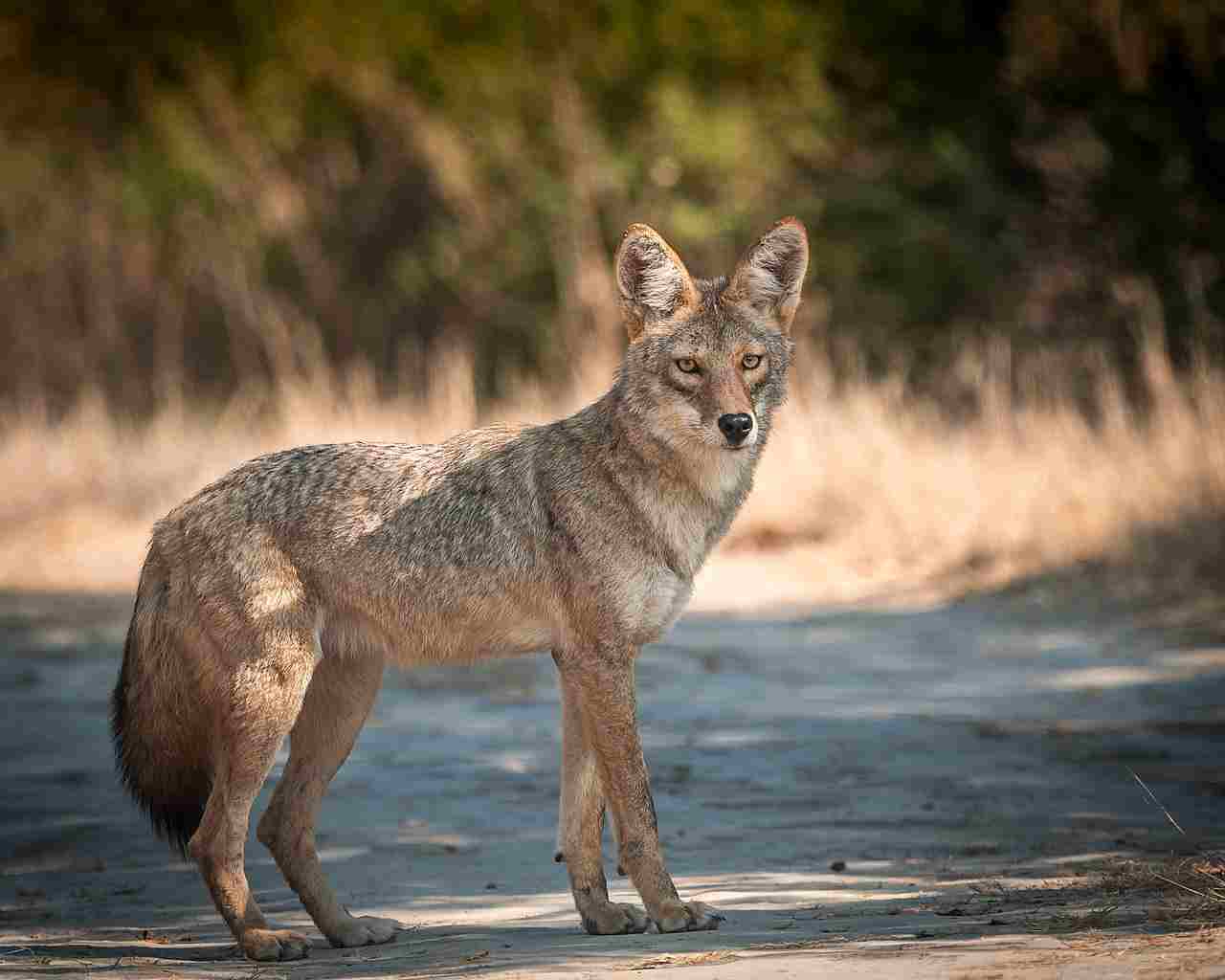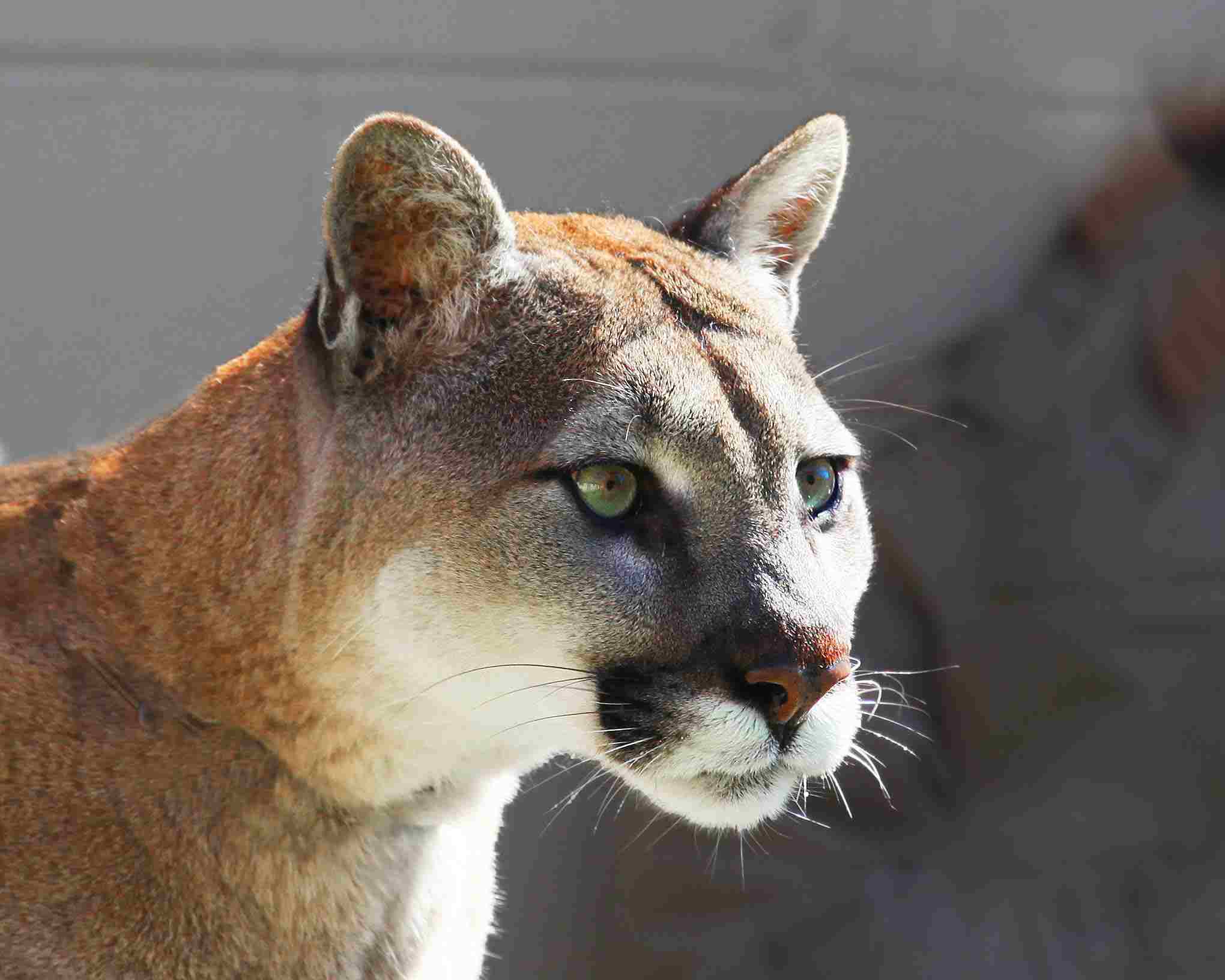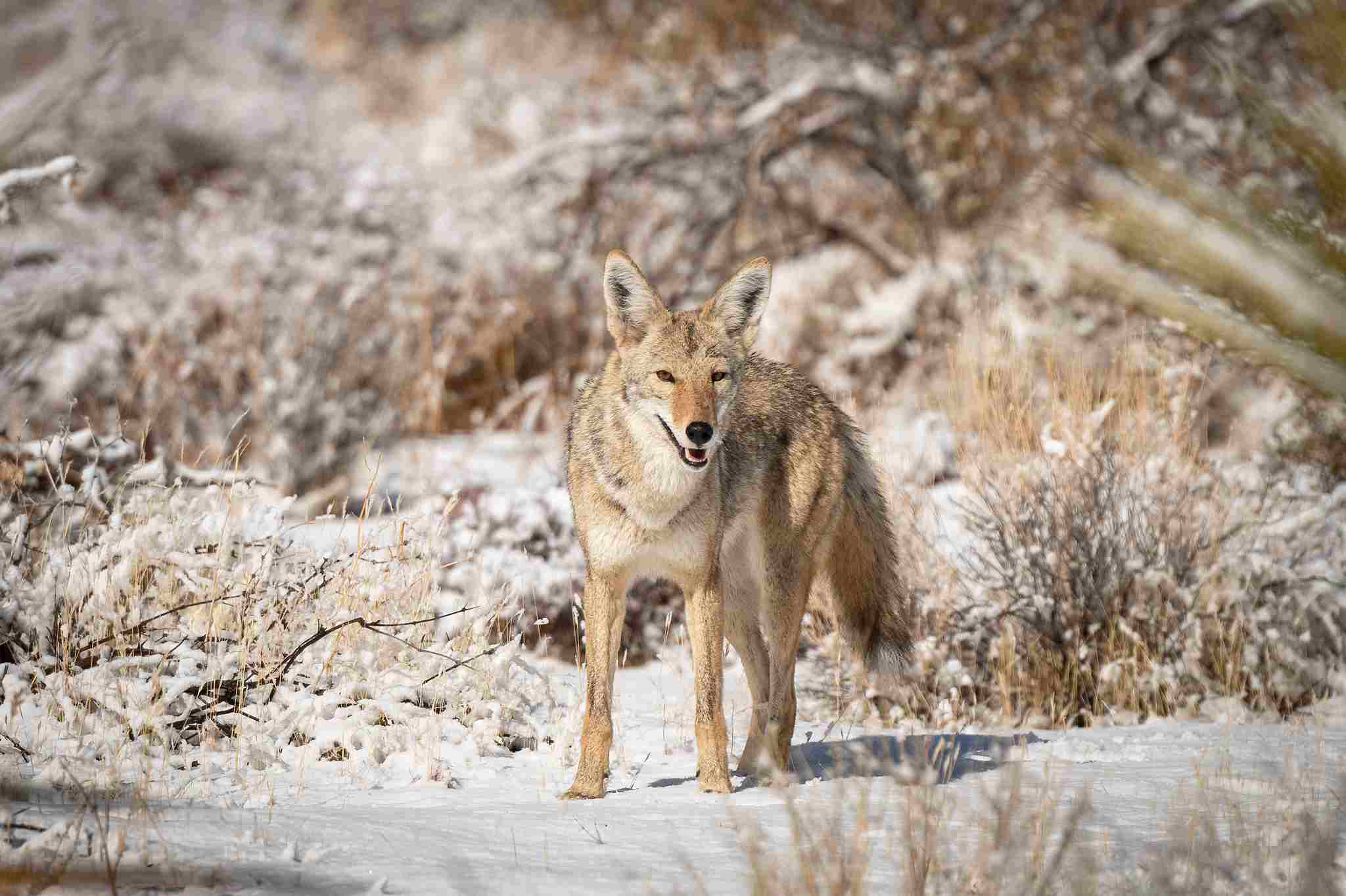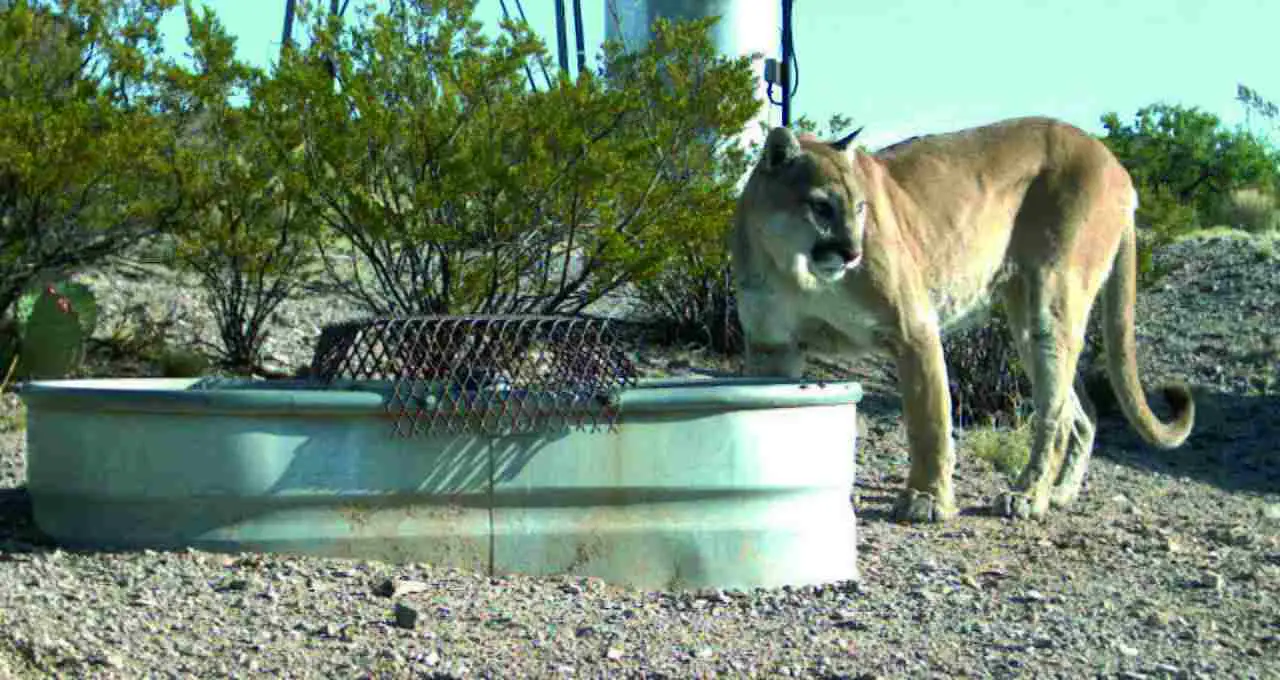Mountain Lion Vs Coyote Size, Weight, Ecological Comparison
Mountain lions have a clear advantage over coyotes in a physical confrontation. They are larger, heavier, and stronger, giving them the upper hand in a fight. Additionally, mountain lions are more agile and possess superior predatory features, such as longer claws and teeth. These factors, along with others like size and weight, are used to compare mountain lions and coyotes in this article. By examining these characteristics, we can understand why a mountain lion would easily overpower a coyote in a fight.
Reasons Why a Mountain Lion Will Win a Coyote In a Fight/Physical Confrontation
I). Size and Weight Advantage
One of the main reasons why a mountain lion would win in a fight against a coyote is its size and weight advantage. Mountain lions are significantly larger and heavier than coyotes, giving them a clear physical advantage.
Adult male mountain lions can weigh between 130 to 220 pounds, while adult male coyotes typically weigh around 30 to 40 pounds. This stark difference in size and weight allows mountain lions to overpower coyotes with ease.

II). Mountain Lions are Much Stronger Than Coyotes
In addition to their size advantage, mountain lions are also much stronger than coyotes. They have well-developed muscles and a robust physique, enabling them to take down larger prey and defend themselves against potential threats.
Coyotes, on the other hand, have a leaner build and are not as powerful as mountain lions. The superior strength of mountain lions gives them a significant edge in a physical confrontation with coyotes.
III). Speed and Agility
Mountain lions are known for their exceptional speed and agility, which further enhances their ability to win in a fight against coyotes. They can reach speeds of up to 50 miles per hour in short bursts, allowing them to quickly chase down and catch their prey.
Coyotes, although agile themselves, cannot match the speed and agility of mountain lions. This speed advantage enables mountain lions to outmaneuver and outpace coyotes in a physical confrontation.
IV). Possession of Superior Predatory Features
Mountain lions possess superior predatory features, such as longer claws and teeth, which give them a distinct advantage over coyotes. Their long, sharp claws are designed for gripping and holding onto prey, while their powerful jaws and sharp teeth allow them to deliver lethal bites. These predatory adaptations make mountain lions more effective hunters and fighters compared to coyotes.
Therefore, the size and weight advantage, superior strength, speed and agility, and possession of superior predatory features all contribute to why a mountain lion would win in a fight against a coyote. These factors make mountain lions formidable opponents and give them the upper hand in a physical confrontation.
*Details of Comparison
| Aspect | Mountain Lions | Coyotes |
| Physical Characteristics | Larger, heavier, and stronger |
Smaller and leaner
|
| Strength | Much stronger than coyotes |
Less powerful than mountain lions
|
| Speed and Agility | Exceptionally fast and agile |
Agile but cannot match the speed of mountain lions
|
| Predatory Features | Longer claws and teeth |
Shorter claws and teeth
|
| Taxonomy | Felidae family and Puma genus |
Canidae family and Canis genus
|
| Appearance | Tan or brown coat, muscular build |
Grayish-brown or reddish-brown coat, slender build
|
| Size | Up to 8 feet in total length, 2.5-3 feet tall |
3-4 feet in total length, 1.5-2 feet tall
|
| Weight | 80-220 pounds | 20-50 pounds |
| Speed | Up to 50 mph | Up to 43 mph |
| Bite Force | Around 600 psi | 150-200 psi |
| Overall Physical Capacity | Larger size, greater muscle mass, endurance |
Smaller size, less muscle mass, lower endurance
|
| Habitat | Diverse habitats, less tolerant of human presence |
Adaptable to various habitats, including urban areas
|
| Lifespan | 10-13 years in the wild |
6-8 years in the wild
|
| Behavior | Solitary hunters, territorial |
Social, cooperative hunting, less aggressive
|
| Reproduction | Viviparous, fewer offspring with more investment |
Viviparous, larger litters with cooperative raising
|
| Danger to Humans | Potentially more dangerous due to size and boldness |
Generally less dangerous, more wary of humans
|
| Intelligence | Highly intelligent, adaptable |
Intelligent, resourceful
|
| Tracks | Larger, rounded tracks with retractable claws |
Smaller, oval-shaped tracks with visible claws
|
| Conservation Status | “Least concern,” but regionally at risk |
Not listed as endangered, adaptable and thriving
|
| Ecological Impact | Maintains ecosystem balance as top predator |
Opportunistic feeder, adaptable to various food sources
|
1). Taxonomy
Mountain lions, scientifically known as Puma concolor, belong to the Felidae family and the Puma genus. On the other hand, coyotes, scientifically known as Canis latrans, belong to the Canidae family and the Canis genus.
While both species are mammals, their taxonomic classification places them in different families and genera. This distinction highlights their evolutionary divergence and unique characteristics.
Mountain lions and coyotes have distinct physical features and behaviors that set them apart. Mountain lions are large, solitary cats with muscular bodies and a distinctive tan or brown coat. Coyotes, on the other hand, are smaller canids with a slender build and a grayish-brown or reddish-brown coat.
In terms of taxonomy, mountain lions and coyotes are classified differently due to their genetic and morphological differences. Understanding their taxonomic classification provides a foundation for further exploration of their physical attributes, behavior, and ecological roles.

2). Appearance
Mountain lions and coyotes have distinct appearances that reflect their evolutionary adaptations and ecological roles.
Starting with their coats, mountain lions have a distinctive tan or brown coat that helps them blend into their natural surroundings. This camouflage allows them to remain hidden while stalking their prey or avoiding potential threats. On the other hand, coyotes have a grayish-brown or reddish-brown coat that provides them with similar camouflage in their habitats.
In terms of stature and build, mountain lions are larger and more muscular than coyotes. They have a sleek and powerful physique, with a long body and a relatively short tail. Coyotes, on the other hand, have a slender build with a bushy tail that they often hold low to the ground.
When comparing the appearance of these animals, it is clear that mountain lions have a more imposing presence due to their larger size and muscular build. Their tan or brown coat helps them blend into their surroundings, making them stealthy predators. Coyotes, although smaller in size, have adapted to their environment with their grayish-brown or reddish-brown coat, allowing them to navigate their habitats effectively.
Understanding the appearance of mountain lions and coyotes provides insights into their physical characteristics and how they have evolved to survive in their respective environments. This knowledge sets the stage for further exploration of their size, weight, and other physical attributes.
3). Size
When comparing the size of mountain lions and coyotes, it is important to consider their total body length and height at the shoulders. Mountain lions are significantly larger than coyotes in both of these aspects.
Mountain lions can reach a total body length of up to 8 feet, including their long tail, and stand at a height of around 2.5 to 3 feet at the shoulders. On the other hand, coyotes have a total body length of around 3 to 4 feet, including their bushy tail, and stand at a height of approximately 1.5 to 2 feet at the shoulders.
The difference in size between these two animals is quite substantial. Mountain lions are almost twice the length and height of coyotes, making them much more formidable in terms of physical presence. This larger size gives mountain lions an advantage when it comes to hunting and taking down prey.
Therefore, the size comparison between mountain lions and coyotes clearly shows that mountain lions are significantly larger in terms of total body length and height at the shoulders.
4). Weight
When comparing the weight of mountain lions and coyotes, it is evident that mountain lions are significantly heavier than coyotes. Mountain lions can weigh anywhere between 80 to 220 pounds, with males generally being larger and heavier than females. On the other hand, coyotes typically weigh between 20 to 50 pounds, with males and females having similar weights.
The difference in weight between these two animals is quite substantial. Mountain lions can weigh up to four times more than coyotes, making them much more powerful and formidable predators. This additional weight gives mountain lions an advantage when it comes to overpowering their prey and defending themselves against potential threats.
The weight of an animal is an important factor in determining its overall physical capacity and hunting abilities. With their larger size and weight, mountain lions have the advantage of being able to take down larger prey and exert more force when necessary. Coyotes, although smaller and lighter, are still skilled hunters but are limited in the size of prey they can successfully tackle.
5). Speed and Agility
Mountain lions are known for their incredible speed and agility, allowing them to chase down and capture their prey with ease. They can reach speeds of up to 50 miles per hour in short bursts, making them one of the fastest land animals.
On the other hand, coyotes are also highly agile and quick on their feet. They are capable of reaching speeds of up to 43 miles per hour, which is impressive considering their smaller size compared to mountain lions. Coyotes are known for their ability to change direction quickly, making them adept at navigating through various terrains.
The speed and agility of these animals play a crucial role in their hunting strategies. Mountain lions rely on their speed to ambush and surprise their prey, while coyotes use their agility to chase and outmaneuver their targets. Both animals possess the necessary skills to be successful predators in their respective habitats.
6). Bite Force
Mountain lions have a much stronger bite force compared to coyotes.
Mountain lions have an average bite force of around 600 pounds per square inch (psi), which is incredibly powerful. This allows them to easily crush the skulls and necks of their prey, ensuring a quick and efficient kill.
On the other hand, coyotes have a bite force of around 150 to 200 psi, which is considerably weaker compared to mountain lions. While still formidable, this bite force is more suited for smaller prey and scavenging rather than taking down larger animals.
The difference in bite force between these two animals is a result of their size and anatomy. Mountain lions have larger heads and jaws, allowing for more muscle mass and a stronger bite. Coyotes, being smaller in size, have relatively smaller heads and jaws, resulting in a less powerful bite force.
7). Overall Physical Capacity (Which is Stronger?)
Mountain lions are known to have a greater overall physical capacity compared to coyotes. This is primarily due to their larger size, weight, and muscle mass. Mountain lions are significantly larger than coyotes, with adult males weighing between 130 to 220 pounds, while coyotes typically weigh around 20 to 50 pounds. The larger size and weight of mountain lions give them a clear advantage in terms of strength and power.
In addition to their size, mountain lions also possess greater muscle mass, which further enhances their physical capacity. Their muscular build allows them to overpower and subdue their prey more effectively. Coyotes, although agile and quick, cannot match the sheer strength and force exerted by mountain lions.
Endurance is another factor that contributes to the overall physical capacity of mountain lions. They are built for long-distance running and have the ability to sustain high levels of activity for extended periods. This endurance advantage allows mountain lions to chase down and exhaust their prey, ultimately leading to a successful kill.
In comparison, coyotes may possess agility and speed, but they lack the size, weight, and endurance of mountain lions. While coyotes are formidable predators in their own right, they would be at a significant disadvantage in a violent confrontation with a mountain lion.
Therefore, the combination of size, weight, muscle mass, and endurance makes mountain lions the stronger of the two animals in terms of their overall physical capacity.
8). Habitat
Mountain lions and coyotes have distinct habitats that reflect their different ecological preferences and geographic ranges.
Mountain lions are adaptable predators that can be found in a variety of ecosystems, including forests, mountains, deserts, and grasslands. They have a wide geographic range, spanning from North America to South America. Mountain lions are known for their ability to navigate diverse terrains and thrive in different climates.
On the other hand, coyotes are highly adaptable and can be found in a range of habitats, including forests, grasslands, deserts, and urban areas. They have a vast geographic range, covering most of North America. Coyotes are known for their ability to adapt to human-altered landscapes and are often found in suburban and urban environments.
While both mountain lions and coyotes can occupy similar habitats, there are some differences in their preferences. Mountain lions tend to prefer more remote and rugged areas, such as mountainous regions and dense forests. They require larger home ranges and are less tolerant of human presence. Coyotes, on the other hand, are more adaptable to human activity and can thrive in fragmented habitats, including agricultural areas and suburban neighborhoods.

9). Lifespan
Mountain lions generally have a longer lifespan compared to coyotes.
Mountain lions have an average lifespan of around 10 to 13 years in the wild, although some individuals have been known to live up to 20 years. Their longer lifespan can be attributed to their position as apex predators, which reduces their risk of predation and increases their chances of survival. Additionally, mountain lions have larger home ranges and require more space, which may contribute to their longer lifespan.
On the other hand, coyotes have a shorter lifespan in the wild, typically ranging from 6 to 8 years. This shorter lifespan can be attributed to various factors, including predation, competition for resources, and exposure to diseases. Coyotes are smaller in size compared to mountain lions and are often preyed upon by larger predators such as wolves and bears. They also face higher mortality rates due to conflicts with humans, including hunting and vehicle collisions.
It’s important to note that lifespan can vary depending on various factors, including habitat quality, availability of prey, and human impacts. In captivity, both mountain lions and coyotes can live longer than their wild counterparts, with some individuals reaching their late teens or early twenties.
10). Behavior
When comparing the behavior of mountain lions and coyotes, several key differences emerge.
In terms of feeding, mountain lions are solitary hunters and primarily prey on large ungulates such as deer. They are ambush predators, relying on stealth and surprise to capture their prey. On the other hand, coyotes are opportunistic omnivores and have a more varied diet, including small mammals, birds, insects, and even fruits and vegetables.
Aggression is another aspect where the two species differ. Mountain lions are known for their territorial behavior and will defend their hunting grounds from intruders. They are generally more aggressive and less tolerant of other individuals. In contrast, coyotes are more adaptable and can form social groups, known as packs, which cooperate in hunting and raising offspring.
Vocalization is also distinct between the two species. Mountain lions are relatively silent animals, with their vocalizations limited to low growls, hisses, and screams during mating or territorial disputes. Coyotes, on the other hand, are highly vocal and communicate through a range of vocalizations, including howls, yips, barks, and growls.
When it comes to social behavior, mountain lions are solitary animals, with minimal social interactions outside of mating. Coyotes, on the other hand, exhibit complex social structures within their packs, with a dominant breeding pair and subordinate members.
In terms of parenting, mountain lion mothers are solely responsible for raising their cubs, providing them with protection and teaching them hunting skills. Coyotes, on the other hand, have a more cooperative parenting system, with both parents and older siblings participating in the care and upbringing of the pups.
Therefore, the behavior of mountain lions and coyotes reflects their different ecological roles and adaptations. While mountain lions are solitary and specialized hunters, coyotes are adaptable and social opportunists.
11). Reproduction
When comparing the reproduction of mountain lions and coyotes, several key differences emerge.
Mountain lions are viviparous, meaning they give birth to live young. After a gestation period of approximately 90 to 96 days, female mountain lions will typically give birth to a litter of one to six cubs. The cubs are born blind and helpless, relying on their mother for nourishment and protection. The female mountain lion will nurse her cubs for about two to three months before gradually introducing them to solid food and teaching them hunting skills.
On the other hand, coyotes are also viviparous and give birth to live young. The gestation period for coyotes is slightly shorter, lasting around 58 to 63 days. Coyote litters can range in size from three to twelve pups, with an average litter size of six. The pups are born with their eyes closed but will open them after about 10 days. The mother coyote will nurse her pups for several weeks before introducing them to regurgitated food and eventually solid prey.
In terms of reproduction, mountain lions and coyotes have different strategies. Mountain lions have fewer offspring but invest more time and energy into raising them individually. Coyotes, on the other hand, have larger litters and rely on the cooperative efforts of the pack to raise the pups.
Overall, the reproductive strategies of mountain lions and coyotes reflect their different ecological adaptations and social structures. Mountain lions prioritize quality over quantity, while coyotes take advantage of their social dynamics to ensure the survival of their offspring.
12). Danger Posed to Humans
When it comes to the danger posed to humans, both mountain lions and coyotes can potentially be a threat, but the mountain lion is generally considered to be more dangerous. Mountain lions are larger, stronger, and more powerful than coyotes, making them capable of inflicting more harm. They are also known to be bolder and more aggressive, especially when they feel threatened or cornered.
While coyotes are generally wary of humans and tend to avoid direct confrontation, mountain lions have been known to come close to human settlements in search of food or territory. This proximity increases the chances of encounters between mountain lions and humans, which can potentially lead to dangerous situations.
In terms of human deaths caused, mountain lions have been responsible for a higher number of fatal attacks compared to coyotes. However, it’s important to note that such incidents are rare and occur only in specific circumstances.
If you encounter a mountain lion or a coyote, it is important to take precautions to ensure your safety. In the case of a mountain lion, it is recommended to avoid running, maintain eye contact, and make yourself appear larger by raising your arms or opening your jacket. Back away slowly and do not turn your back on the animal. If a coyote approaches, it is best to make loud noises, wave your arms, and throw objects to scare it away.
13). Intelligence
When comparing the intelligence of mountain lions and coyotes, it is important to consider their respective behaviors and adaptability. Both animals exhibit a level of intelligence that allows them to survive and thrive in their respective habitats.
Mountain lions, also known as cougars or pumas, are highly intelligent predators. They possess excellent problem-solving skills and are capable of learning from their experiences. Their intelligence is evident in their hunting techniques, as they are known to stalk their prey and strategically plan their attacks. Mountain lions also display a high level of adaptability, allowing them to thrive in various environments.
On the other hand, coyotes are also intelligent animals. They have shown remarkable adaptability to changing environments and are known for their resourcefulness. Coyotes are highly adaptable hunters and have been observed using cooperative hunting strategies to catch their prey. They are also known for their ability to learn from their interactions with humans, which has allowed them to successfully navigate urban environments.
In terms of which animal is more intelligent, it is difficult to determine definitively. Both mountain lions and coyotes possess unique cognitive abilities that enable them to survive and thrive in their respective ecosystems. Their intelligence is tailored to their specific needs and behaviors, making it challenging to compare them directly.
14). Tracks
When comparing the tracks of mountain lions and coyotes, there are distinct differences that can help identify which animal left the mark. Mountain lion tracks are larger and more rounded, measuring around 3 to 4 inches in diameter. They have four toes with retractable claws, and the hind tracks often overlap the front tracks. The overall shape of the track is similar to that of a domestic cat but much larger in size.
On the other hand, coyote tracks are smaller and more oval-shaped, measuring around 2 to 2.5 inches in diameter. They also have four toes with claws, but the claws are usually more visible in coyote tracks compared to mountain lion tracks. The hind tracks are typically smaller and slightly offset from the front tracks.
These differences in track size and shape can be useful in distinguishing between the two animals in the wild. By examining the tracks, wildlife trackers and researchers can determine the presence and movement patterns of mountain lions and coyotes in a particular area.
It is important to note that while tracks can provide valuable information, they should be analyzed in conjunction with other signs, such as scat, hair, and scratch marks, to get a more accurate understanding of the animal’s behavior and presence in the ecosystem.
15). Conservation Status
The conservation status of mountain lions and coyotes varies, with mountain lions being more at risk compared to coyotes. Mountain lions are classified as a species of “least concern” by the International Union for Conservation of Nature (IUCN), indicating that their population is relatively stable. However, in certain regions, such as the western United States, mountain lions are considered a “species of concern” due to habitat loss, fragmentation, and conflicts with humans.
On the other hand, coyotes are not currently listed as endangered or threatened. They are highly adaptable and can thrive in a variety of habitats, including urban areas. Their population has actually increased in some regions due to human activities, such as the clearing of forests and the creation of open spaces.
The main threats to the survival of wild mountain lion populations include habitat loss, fragmentation, and human-wildlife conflicts. As human development expands into natural areas, mountain lions face increased competition for resources and encounters with humans, which can lead to conflicts and even lethal control measures. Additionally, the fragmentation of their habitat can isolate populations, reducing genetic diversity and making them more vulnerable to disease and other threats.
In comparison, coyotes are more resilient to these threats due to their adaptability and ability to exploit a wide range of food sources. They can survive in fragmented habitats and have even expanded their range into urban areas. However, they can still face persecution and lethal control measures in some regions due to conflicts with livestock and pets.

Conclusion
I). SIMILARITIES
In comparing mountain lions and coyotes, there are several similarities between these two animals. Both species belong to the same family, Canidae, and share certain physical characteristics.
They are both carnivorous predators, with sharp teeth and claws that they use for hunting and capturing prey. Additionally, both mountain lions and coyotes are highly adaptable and can survive in a variety of habitats, including forests, grasslands, and even urban areas.
II). DIFFERENCES
Despite their similarities, there are also notable differences between mountain lions and coyotes. One significant difference is their size. Mountain lions are much larger and heavier than coyotes, with adult males weighing between 100 and 200 pounds, while coyotes typically weigh between 20 and 50 pounds. Another difference is their hunting behavior.
Mountain lions are solitary hunters and primarily prey on larger animals, such as deer, while coyotes are more social and often hunt in packs, targeting smaller prey like rodents and rabbits.
In terms of ecological impact, mountain lions play a crucial role in maintaining the balance of ecosystems as top predators, regulating prey populations and preventing overgrazing. Coyotes, on the other hand, have a more opportunistic feeding behavior and can adapt their diet to various food sources, including scavenging.

